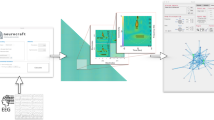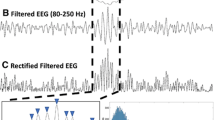Abstract
Localizing epileptic networks is a central challenge in guiding epilepsy surgery, deploying antiepileptic devices, and elucidating mechanisms underlying seizure generation. Recent work from our group and others suggests that high-frequency epileptic oscillations (HFEOs) arise from brain regions constituting epileptic networks, and may be important to seizure generation. HFEOs are brief 50–500 Hz pathologic events measured in intracranial field and unit recordings in patients with refractory epilepsy. They are challenging to detect due to low signal to noise ratio, and because they occur in multiple channels with great frequency. Their morphology is also variable and changes with distance from intracranial electrode contacts, which are sparsely placed for patient safety. Thus reliable, automated methods to detect HFEOs are required to localize and track seizure generation in epileptic networks. We present a novel method for mapping the temporal evolution of these oscillations in human epileptic networks. The technique combines a particle swarm optimization algorithm with a neural network to create features that robustly detect and track HFEOs in human intracranial EEG (IEEG) recordings. We demonstrate the algorithm’s performance on IEEG data from six patients, one pediatric and five adult, and compare it to an existing method for detecting high-frequency oscillations.









Similar content being viewed by others
References
Berger H. (1929) Über das Elektroenkephalogram des Menschen. Arch. f. Psychiat 87:527–570
Bragin A., Wilson C. L., Staba R. J. (2002) Interictal high-frequency oscillations (80–500Hz) in the human epileptic brain: entorhinal cortex. Ann. Neurol. 52:407–415
Duda R., Hart P., Stork D. (2001) Pattern Classification, 2nd edition. New York, NY: John Wiley & Sons, Inc
Engel J. (1987) Surgical Treatment of the Epilepsies 1st ed. Vol. 1. New York, NY: Raven Press
Firpi, H. On prediction and detection of epileptic seizures by means of genetic programming artificial features. Ph.D. dissertation. Michigan State University, 2005
Haykin S. (1999) Neural Networks: A Comprehensive Foundation. 2nd ed. Upper Saddle River, NJ, Prentice Hall
Jirsch J. D., Urrestarazu E., LeVan P., Oliver A., Dubeau F., Gotman J. (2006) High-frequency oscillations during human focal seizure. Brain 129(6):1593–1608
Kennedy, J., and R. C. Eberhart. Swarm Intelligence. Morgan Kaufmann Publishers, 2001
Kennedy J., Eberhart R. C. (1995) Particle Swarm Optimization. Proc. IEEE Int. Confer. Neural Networks 4:1942–1948
Kil, D. H., and F. B. Shin. Pattern recognition and predictions with to applications to signal characterization. AIP Press, 1996
Litt B., Esteller R., Echauz J., D’Alessandro M., Shor R., Henry T., Pennell P., Epstein C., Bakay R., Dichter M., Vachtsevanos G. (2001) Epileptic seizures may begin hours in advance of clinical seizures: a report of five patients. Neuron 29(4):51–64
Marin-Padilla M. (2000) Acquired cortical dysplasia and epilepsy. Int. Pediatr. 15(2):73–83
Quesney L. F. (2000) Intracranial EEG investigation in neocorical epilepsy. Adv. Neurol. 84:253–274
Schiff S. J., Sauer T., Kumar R., Weinstein S. L. (2005) Neuronal spatiotemporal pattern discrimination: the dynamical evolution of seizures. Neuroimage 28:1043–1055
Shi, Y. and E. C. Eberhart. Parameter selection in particle swarm optimization. In: Evolutionary Programming VII: Lectures Notes in Computer Science, 1998, pp. 591–600
Smart, O. Evolutionary algorithms and frequent itemset mining for analyzing epileptic seizure precursors. Ph.D. Dissertation. Georgia Institute of Technology, 2006
Smart, O., G. A. Worrell, B. Litt, and G. Vachtsevanos. Automatic detection of high frequency epileptic oscillations from the intracranial EEG of patients with neocortical epilepsy. Technical, Professional, and Student Development Workshop, 2005
Staba R. J., Wilson C. L., Bragin A., Fried I., Engel J. Jr. (2002) Quantitative analysis of high-frequency oscillations (80–500 Hz) recorded in human epileptic hippocampus and entorhinal cortex. J. Neurophysiol. 88:1743–1752
Worrell G. A., Parish L., Cranstoun S. D., Jonas R., Baltuch G., Litt B. (2004) High frequency oscillations and seizure generation in neocortical epilepsy. Brain 127:1–11
Author information
Authors and Affiliations
Corresponding author
Rights and permissions
About this article
Cite this article
Firpi, H., Smart, O., Worrell, G. et al. High-Frequency Oscillations Detected in Epileptic Networks Using Swarmed Neural-Network Features. Ann Biomed Eng 35, 1573–1584 (2007). https://doi.org/10.1007/s10439-007-9333-7
Received:
Accepted:
Published:
Issue Date:
DOI: https://doi.org/10.1007/s10439-007-9333-7




